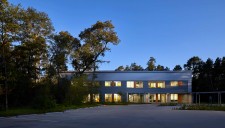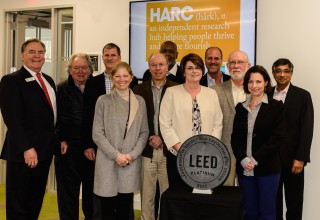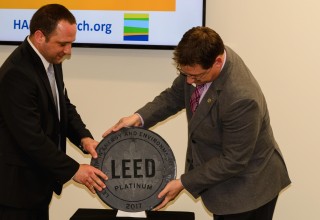HARC Awarded Prestigious LEED Platinum Green Building Certification

The Woodlands, Texas, February 9, 2018 (Newswire.com) - The Houston Advanced Research Center (HARC) announces today that it has been awarded LEED® Platinum certification. The Platinum certification is the highest environmental building achievement attainable by the U.S. Green Building Council (USGBC), making HARC the first LEED Platinum building in The Woodlands and Montgomery County and pushing them one step closer to becoming a Net Zero Energy Building.
“HARC’s nonprofit mission has long been grounded in the tenants of sustainability. HARC and its Board of Directors made the commitment to LEED Platinum from the very beginning of the design process,” said Lisa Gonzalez, HARC President & Chief Executive Officer.
This building also serves as an example to others in The Woodlands, Montgomery County and throughout the Greater Houston region of how buildings like HARC's can be designed, constructed and operated sustainably by commercial entities of all sizes.
Lisa Gonzalez, HARC President & Chief Executive Officer
“Our goal was a highly energy-and water-efficient building sited in a manner that conserves habitat, uses native landscaping and incorporates low impact development strategies. This building also serves as an example to others in The Woodlands, Montgomery County and throughout the Greater Houston region of how buildings like HARC’s can be designed, constructed and operated sustainably by commercial entities of all sizes.”
On Tuesday, February 6, HARC held a Plaque Ceremony in celebration of the LEED Platinum achievement, including members of HARC’s Board, the USGBC, community leaders and building partners. Gonzalez addressed the group, followed by remarks from the Executive Director of USGBC’s Texas Chapter, Jonathan Kraatz.
“Achieving LEED certification is more than implementing sustainable practices. It represents a commitment to making the world a better place and influencing others to do better,” said Kraatz. “HARC’s LEED Platinum building, together with its mission to provide independent analysis on energy, air, and water issues, will continue to serve as a model for sustainability in Houston, The Woodlands and beyond.”
Also speaking at the celebration were Todd Mitchell, Chairman of HARC’s Board of Directors; Rives Taylor, Regional Sustainability Leader and Firmwide Design Resilience Director for Gensler; and Ryan Busking, Vice President for Brookstone Construction Managers. The ceremony concluded with an unveiling of the LEED Platinum Plaque, guided building tours, and an introduction to HARC’s Building Dashboard—an information tool developed by HARC to share information about the building’s energy and water usage.
“HARC’s new building is a living laboratory that embodies what our sustainability mission represents,” said Mitchell. “This vision has been part of my journey with HARC since 2001 and a dream shared by the Mitchell family.”
The key sustainable elements in HARC’s building, which contributed to the LEED Platinum rating revolve around energy efficiency, water stewardship and materials reduction.
- Water Stewardship: Rainfall runoff from the roof and parking lot of HARC is directed toward vegetated bioswales. The bioswales feature native and water smart plants and run adjacent to the preserved forest habitats. Natural and restored habitats facilitate landscape regeneration. Low-flow water fixtures in the building are calibrated to reduce potable water use.
- Energy Efficiency: The new facility features geothermal heat exchange, a high-performance building envelope and rain screen, appropriately sized mechanical and air distribution systems, and day lighting. A share of the building’s electricity needs will be generated from roof mounted solar photovoltaics. Through these strategies, the campus is on track to attain “Net Zero” operational status.
- Materials Reduction: Building design seeks to lessen the carbon footprint of the structural systems as well as minimize layers of finished materials where possible; exposed structure and polished concrete floors are examples of strategies employed. Thirty-one percent of materials used in the building were obtained from the local region. All building finishes were low in volatile organic compound (VOC) content. Building waste was minimized and 88 percent of waste generated during construction was recycled.
“In starting the design process with HARC, it was important that we began with the end in mind,” said Rives Taylor, architect and designer of the building. “We began by setting clear, lifecycle goals with HARC’s leadership on the layout, programming and sustainability outcomes desired for their new building, which allowed us to work efficiently and cost effectively throughout the design, engineering and construction. The purpose of this collaborative process was to deliver a productive workspace and resource stewardship with an operational mindset – which we are thrilled to see come to life today.”
The LEED (Leadership in Energy and Environmental Design) rating system, developed by the USGBC, is the foremost program for buildings, homes and communities that are designed, constructed, maintained and operated for improved environmental and human health performance.
For information about HARC’s design and construction process from start to finish, please follow the link HERE. HARC’s new, high-performance headquarters building was funded through capital campaign donations from the Endowment for Regional Sustainability Science, Houston Endowment, and The Cynthia and George Mitchell Foundation.
HARC was founded in 1982 by George P. Mitchell and works as a nonprofit research hub providing independent analysis on energy, air, and water issues to people seeking scientific answers. HARC is focused on building a sustainable future that helps people thrive and nature flourish. Learn more at HARCResearch.org.
Gensler is a global design firm grounded in the belief that great design optimizes business performance and human potential. The firm’s 5,000 practitioners networked across 45 offices use global perspective and local presence to innovate at every scale. Whether refreshing a retailer’s brand, planning a new urban district or designing a super tall building, Gensler strives to make the everyday places people occupy more inspiring, more resilient, and more impactful. Learn more at Gensler.com.
Source: Houston Advanced Research Center (HARC)




